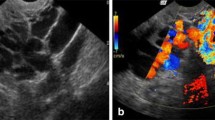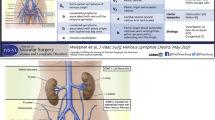Abstract
Purpose
This study was designed to evaluate the clinical outcome and patients’ satisfaction after a 5 year follow-up period for pelvic congestion syndrome (PCS) coil embolization in patients who suffered from chronic pelvic pain that initially consulted for lower limb venous insufficiency.
Methods
A total of 202 patients suffering from chronic pelvic pain were recruited prospectively in a single center (mean age 43.5 years; range 27–57) where they were being treated for lower limb varices. Inclusion criteria were: lower limb varices and chronic pelvic pain (>6 months), >6 mm pelvic venous caliber in ultrasonography, and venous reflux or presence of communicating veins. Both ovarian and hypogastric veins were targeted for embolization. Pain level was assessed before and after embolotherapy and during follow-up using a visual analog scale (VAS). Technical and clinical success and recurrence of leg varices were studied. Patients completed a quality questionnaire. Clinical follow-up was performed at 1, 3, and 6 months and every year for 5 years.
Results
Technical success was 100 %. Clinical success was achieved in 168 patients (93.85 %), with complete disappearance of symptoms in 60 patients (33.52 %). Pain score (VAS) was 7.34 ± 0.7 preprocedural versus 0.78 ± 1.2 at the end of follow-up (P < 0.0001). Complications were: groin hematoma (n = 6), coil migration (n = 4), and reaction to contrast media (n = 1). Twenty-three cases presented abdominal pain after procedure. In 24 patients (12.5 %), there was recurrence of their leg varices within the follow-up. The mean degree of patients’ satisfaction was 7.4/9.
Conclusions
Coil embolization of PCS is an effective and safe procedure, with high clinical success rate and degree of satisfaction.





Similar content being viewed by others
References
Robinson JC (1993) Chronic pelvic pain. Curr Opin Obstet Gynecol 5:740–743
Cordts PR, Eclavea A, Buckley PJ et al (1998) Pelvic congestion syndrome: early clinical results after transcatheter ovarian vein embolization. J Vasc Surg 28:862–868
Liddle AD, Davies AH (2007) Pelvic congestion syndrome: chronic pelvic pain caused by ovarian and internal iliac varices. Phlebology 22:100–104
Jung SC, Lee W, Chung JW et al (2009) Unusual causes of varicose veins in the lower extremities: CT, venographic and Doppler US findings. Radiographics 29:525–536
Ahumada M, Vioque J (2004) Prevalence and risk factors of varicose veins in adults. Med Clin 123:647–651
Meissner MH, Gloviczki P, Bergan J et al (2007) Primary chronic venous disorders. J Vasc Surg 46:54S–67S
Carpentier PH, Maricq HR, Biro C et al (2004) Prevalence, risk factors, and clinical patterns of chronic venous disorders of lower limbs: a population-based study in France. J Vasc Surg 40:650–659
Kostas T, Ioannou CV, Touloupakis E et al (2004) Recurrent varicose veins after surgery: a new appraisal of a common and complex problem in vascular surgery. Eur J Vasc Endovasc Surg 27:275–282
Greiner M, Gilling-Smith GL (2007) Leg varices originating from the pelvis: diagnosis and treatment. Vascular 15:70–78
Kies DD, Kim HS (2012) Pelvic congestion syndrome: a review of current diagnostic and minimally invasive treatment modalities. Phlebology 27:52–57
Black CM, Thorpe K, Venbrux A et al (2010) Research reporting standards for endovascular treatment of pelvic venous insufficiency. J Vasc Interv Radiol 21(796):803
Wewers ME, Lowe NKA (1990) Critical review of visual analogue scales in the measurement of clinical phenomena. Res Nurs Health 13:227–236
Park SJ, Lim JW, Ko YT et al (2004) Diagnosis of pelvic congestion syndrome using transabdominal and transvaginal sonography. AJR Am J Roentgenol 182:683–688
Stones RW (2003) Pelvic vascular congestion-half a century later. Clin Obstet Gynecol 46:831–836
Hobbs JT (2005) Varicose veins arising from the pelvis due to ovarian vein incompetence. Int J Clin Pract 59:1195–1203
Gargiulo T, Mais V, Brokaj L et al (2003) Bilateral laparoscopic transperitoneal ligation of ovarian veins for treatment of pelvic congestion syndrome. J Am Assoc Gynecol Laparosc 10:501–504
Capasso P, Simons C, Trotteur G et al (1997) Treatment of symptomatic pelvic varices by ovarian vein embolization. Cardiovasc Intervent Radiol 20:107–111
Venbrux AC, Chang AH, Kim HS et al (2002) Pelvic congestion syndrome (pelvic venous incompetence): impact of ovarian and internal iliac vein embolotherapy on menstrual cycle and chronic pelvic pain. J Vasc Interv Radiol 13:171–178
Kim HS, Malhotra AD, Rowe PC et al (2006) Embolotherapy for pelvic congestion syndrome: long-term results. J Vasc Interv Radiol 17:289–297
Kwon SH, Oh JH, Ko KR et al (2007) Transcatheter ovarian vein embolization using coils for the treatment of pelvic congestion syndrome. Cardiovasc Intervent Radiol 30:655–661
Smith PC (2012) The outcome of treatment for pelvic congestion syndrome. Phlebology 27:74–77
Gloviczki P, Comerota AJ, Dalsing MC et al (2011) The care of patients with varicose veins and associated chronic venous diseases: clinical practice guidelines of the Society for Vascular Surgery and the American Venous Forum. J Vasc Surg 53:2S–48S
Ratnam LA, Marsh P, Holdstock JM et al (2008) Pelvic vein embolisation in the management of varicose veins. Cardiovasc Intervent Radiol 31:1159–1164
Marsh P, Holdstock J, Harrison C et al (2009) Pelvic vein reflux in female patients with varicose veins: comparison of incidence between a specialist private vein clinic and the vascular department of a National Health Service District General Hospital. Phlebology 24:108–113
Gad MA, Saber A, Hokkam EN (2012) Assessment of causes and patterns of recurrent varicose veins after surgery. N Am J Med Sci 4:45–48
Milone M, Salvatore G, Maietta P et al (2011) Recurrent varicose veins of the lower limbs after surgery. Role of surgical technique (stripping vs. CHIVA) and surgeon’s experience. G Chir 32:460–463
Gültaşli NZ, Kurt A, Ipek A et al (2006) The relation between pelvic varicose veins, chronic pelvic pain and lower extremity venous insufficiency in women. Diagn Interv Radiol 12:34–48
Acknowledgments
The authors thank Luis Cebrian, Radiology Department, Hospital Clínico Universitario (Zaragoza, Spain), for his help with English and Dr. Sergio Sierre, Interventional Radiology Department, Hospital Nacional de Pediatría J.P. Garrahan (Buenos Aires, Argentina) for his insightful comments and discussion
Conflict of interest
Alicia Laborda, Joaquin Medrano, Ignacio de Blas, Ignacio Urtiaga, and Francisco Cesar Carnevale have no conflict of interest or financial ties to disclose. Miguel A. de Gregorio is proctor for Cook Medical, with no conflicts of interest in this paper.
Author information
Authors and Affiliations
Corresponding author
Rights and permissions
About this article
Cite this article
Laborda, A., Medrano, J., de Blas, I. et al. Endovascular Treatment of Pelvic Congestion Syndrome: Visual Analog Scale (VAS) Long-Term Follow-up Clinical Evaluation in 202 Patients. Cardiovasc Intervent Radiol 36, 1006–1014 (2013). https://doi.org/10.1007/s00270-013-0586-2
Received:
Accepted:
Published:
Issue Date:
DOI: https://doi.org/10.1007/s00270-013-0586-2




